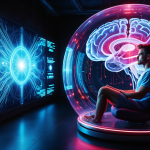
AI’s Unleashed Perils: Prepare for the Onslaught of Real-Life Doppelgängers
June 30, 2024
The Fascinating World of Doppelgangers: More Than Meets the Eye
Have you ever encountered someone who looks strikingly similar to you or someone you know, even though you’re not related? These “twin strangers” or doppelgangers have long been a subject of fascination in popular culture. Recent research suggests that the uncanny resemblance between counterparts may be more than skin deep. A study published in Cell Reports found that people with very similar faces also share many of the same genes and lifestyle traits. The researchers compared the DNA of 16 pairs of doppelgangers and discovered that 9 shared significant genetic variations, making them “virtual twins”.
The concept of doppelgangers has gained significant traction in recent years, partly due to the bandwagon effect. As more people share their doppelganger stories on social media, others are inspired to seek out their look-alikes. This collective fascination has led to the creation of websites and apps dedicated to finding one’s counterpart, further fueling the trend.
However, not everyone is convinced by the doppelganger phenomenon. Some sceptics argue that the perceived similarities between look-alikes are often exaggerated or based on superficial traits. They contend that the human brain is wired to seek patterns and similarities, which may lead to overestimating individual likeness.
Behavioral Implications of Doppelgangers
Interestingly, the study also revealed that doppelgangers often share similar behaviours, such as smoking and education levels. This suggests that our genes influence our physical appearance and shape our lifestyle choices. From a behavioural perspective, this raises intriguing questions about the nature of free will and the extent to which our genetic makeup predetermines our actions.
As artificial intelligence advances, creating even more convincing doppelgangers may soon become possible. AI-powered tools could analyze a person’s facial features, voice, and mannerisms to generate a virtual look-alike that resembles them physically and mimics their behaviour. While this technology is still in its early stages, it raises intriguing questions about the nature of identity and the potential applications (and risks) of creating digital doubles.
Today, we’ll delve into AI’s pivotal role in crafting virtual doppelgangers and the alarming hazards they pose. While real-life look-alikes, or counterparts, may exist, the virtual replicas synthesized by AI harbour profound risks. Your digital twin could be out there, scheming to exploit your hard-earned assets, posing a significant threat to your security.
In the face of this rapidly advancing AI cycle, it becomes evident that our initial expectations have been surpassed. We were among the first to recognize and discuss the immense potential of AI, even during a time when it seemed like a mere fantasy. Back then, we would jest about “body shops” where one could walk in and have any body part replaced. However, astonishingly, we are on the verge of 3D organ printing becoming a reality.
The Dark Side of AI-Generated Doppelgangers: Identity Theft and Financial Harm
AI-powered tools create convincing digital replicas that can be exploited for malicious purposes, such as identity theft and financial fraud. By analyzing an individual’s facial features, voice, and mannerisms, these tools can generate virtual look-alikes that closely resemble the target.
Criminals are leveraging this technology to create fake profiles on social media and online banking platforms, allowing them to access sensitive information and steal funds from unsuspecting victims. For example, an AI-generated doppelganger could be used to create a fraudulent video of a bank manager requesting account details from a customer, tricking them into revealing confidential information.
Moreover, these virtual doppelgangers can be used to apply for credit cards, loans, or other financial services in the victim’s name, causing significant damage to their credit score and economic well-being. The consequences of such identity theft can be devastating, leaving victims struggling to prove their innocence and recover from the financial harm inflicted upon them.
Fortifying Your Digital Identity Against AI-Powered Doppelganger Threats: A Psychological Perspective
Protecting your digital identity has become a psychological imperative in today’s hyperconnected world. The rise of artificial intelligence (AI) has introduced new threats, such as convincing digital replicas that can be used for malicious purposes like identity theft and financial fraud. These AI-powered doppelgangers pose a financial risk and can significantly impact an individual’s sense of self and security.
To combat these AI-based threats, it’s essential to adopt a multi-layered approach that addresses both technological and psychological aspects:
1. Strong and unique passwords: Create complex passwords for your online accounts and regularly update them. This practice enhances security and provides a sense of control and agency over your digital presence.
2. Two-factor authentication (2FA): Enable 2FA whenever possible. Psychologically, this additional step reinforces the idea that your identity is worth protecting and creates a mental barrier against potential threats.
3. Regular software updates: Keep your systems up-to-date. This habit cultivates a mindset of proactive defence and adaptability in the face of evolving threats.
4. Comprehensive identity theft protection: Consider using all-in-one solutions like Aura. These services can provide peace of mind and alleviate anxiety associated with potential identity theft.
5. Vigilance and awareness: Stay informed about potential threats and be cautious when sharing personal information online. This practice fosters healthy scepticism and critical thinking skills, essential in the digital age.
However, adopting a contrarian perspective is crucial, as well as recognising that excessive focus on digital security can lead to paranoia and social isolation. While protection is necessary, maintaining a balance between security and openness is essential for psychological well-being. Some contrarian approaches include:
1. Embracing controlled vulnerability: Occasionally sharing personal experiences online can foster genuine connections and build resilience against the fear of digital threats.
2. Questioning the narrative of constant threat: While risks exist, critically evaluate the messaging around digital dangers to avoid falling into perpetual anxiety.
3. Exploring the benefits of AI: Instead of viewing AI solely as a threat, consider how it can enhance personal security and improve digital experiences.
Individuals, businesses, and governments must collaborate to address these evolving threats as AI advances. This includes implementing strong cybersecurity measures, educating users about best practices, and developing AI-powered defensive systems to detect and respond to attacks in real time.
Taking proactive steps to fortify your digital identity while maintaining a balanced perspective can significantly reduce the risk of falling victim to AI-powered doppelganger threats. This approach safeguards your personal and financial well-being and promotes psychological resilience in an increasingly digital world.
As AI advances, it’s more important than ever to stay informed about potential threats and to take steps to protect your online security.
To assess the strength of your password, use this link: https://www.passwordmonster.com
The Evolving Landscape of AI Voice Scams: A Growing Threat
As artificial intelligence continues to advance, so do the tactics of scammers exploiting this technology. Recent incidents highlight the alarming rise of AI-powered voice impersonation scams, leaving victims emotionally and financially devastated.
Diverse Targets, Similar Tactics
These scams are not limited to a specific demographic or region. In Canada, a couple lost approximately Rs 18 lakh (about $21,000) to a scammer impersonating their grandson. In Alabama, a family was rattled by an AI-generated call mimicking their daughter’s voice, claiming her husband was dead. In Ontario, a man lost $8,000 to a scam involving an AI-cloned voice of his friend.
Psychological Impact and Vulnerability
The psychological toll of these scams is significant. Victims report experiencing visceral horror upon hearing what they believe to be their loved ones in distress. This emotional manipulation makes people, especially the elderly, particularly vulnerable to such scams.
Rapid Technological Advancements
The technology behind these scams is evolving at an alarming rate. Microsoft recently unveiled an AI system capable of recreating a person’s voice after just three seconds of listening. This rapid advancement makes it increasingly difficult for victims to distinguish between authentic and AI-generated voices.
Contrarian Perspective: The Double-Edged Sword of AI
While the focus has been on the threats posed by AI voice cloning, it’s essential to consider the potential benefits of this technology. AI-generated voices could enhance accessibility for individuals with speech impairments or preserve the voices of loved ones for future generations. The challenge lies in balancing innovation with security.
Psychological Strategies for Protection
To combat these scams, experts recommend developing a healthy scepticism towards unexpected calls, even if they seem to come from loved ones. Cultivating a habit of verification and maintaining open communication channels with family members can serve as psychological safeguards against manipulation.
Emerging Solutions and Future Outlook
As the threat evolves, so do the countermeasures. Cybersecurity experts are developing AI-powered defensive systems to detect and flag potential voice scams in real-time. Additionally, there’s a growing call for stricter regulations and ethical guidelines for developing and using AI voice technology.
In conclusion, while AI voice scams present a significant challenge, awareness, education, and technological solutions offer hope for mitigating this threat. As we navigate this new landscape, we must stay informed, remain vigilant, and approach unexpected communications with a critical mindset, regardless of how convincing they may seem.
AI Doppelgangers: The Merging of Technology and Identity Threats
With the advancement of AI technology, the concept of doppelgangers has evolved from folklore to a modern-day concern. AI-generated deep fakes, impersonation scams, and identity replication pose significant threats to individuals and organizations.
AI-Generated Deep Fakes and Cybercrime:
AI-powered tools can now create compelling fake videos, images, and audio that deceive even discerning individuals. In a recent case, deepfake technology was used to create a video of Ukrainian President Volodymyr Zelenskyy appearing to call on his soldiers to lay down their arms, causing brief panic before it was debunked.
Impersonation Scams and Voice Cloning:
AI-powered voice cloning enables fraudsters to impersonate loved ones or authoritative figures. Recent incidents include:
– A Texas woman lost $10,000 after receiving a call from an AI-generated voice claiming to be her son in jail
– A British energy company CEO being tricked into transferring €220,000 to a Hungarian supplier after receiving a call from an AI-cloned voice of his German boss
– An Arizona family received a ransom call with their daughter’s AI-cloned voice demanding $1 million
AI Voice Cloning Systems and Security Concerns:
Researchers at the University of Chicago have developed an AI system that can clone a person’s voice from just three seconds of audio. While this technology promises legitimate uses, it raises concerns about potential misuse in identity theft and fraud.
The Impact on Influencers and Social Media:
Deepfake doppelgangers pose a significant threat to the influencer industry. In South Korea, virtual influencers like Rozy and Lucy are gaining popularity, with Rozy alone securing over 100 sponsorship deals worth nearly $1 million, blurring the lines between actual and AI-generated content.
Future Implications:
As AI evolves, every facet of our distinctive identity can be recreated, leading to:
– Increased misinformation and propaganda
– More sophisticated scams and fraud
– Challenges in data and identity protection
– Ethical considerations balancing innovation and responsible use
To address these challenges, individuals, organizations, and policymakers must:
1. Implement robust security measures
2. Foster public awareness and digital literacy
3. Establish ethical guidelines for AI development and use
4. Develop advanced detection and authentication technologies
As we navigate this new landscape, we must stay informed, remain vigilant, and approach unexpected communications with a critical mindset, regardless of how convincing they may seem.
Conclusion
AI advancements have far-reaching implications for society, including potentially replicating personal identities and ethical dilemmas. The ability to recreate voices, appearances, and mannerisms raises concerns about privacy and security. AI-generated deep fakes and voice clones can spread misinformation, facilitate scams, and compromise data and identities. Robust authentication, encryption, and backup systems are crucial to address these challenges. Regulatory bodies and policymakers work to establish guidelines, ensuring responsible AI use and preventing misuse. The convergence of AI and doppelganger threats requires a multi-faceted response, from password security to advanced authentication. As AI evolves, staying vigilant and proactive is essential for a safer digital world, mitigating risks, and protecting digital identities.














